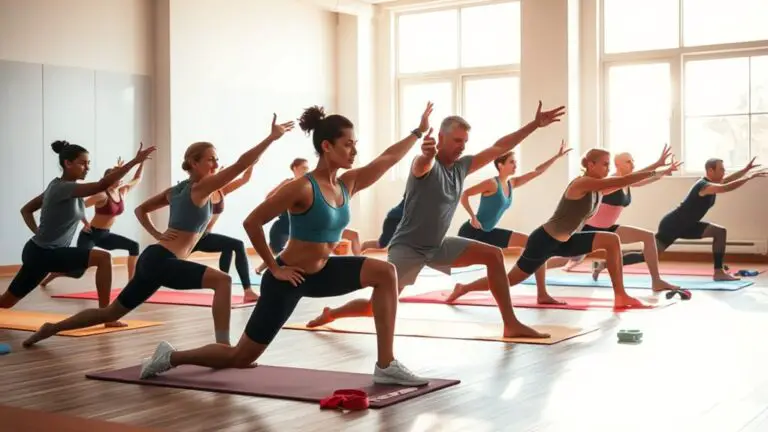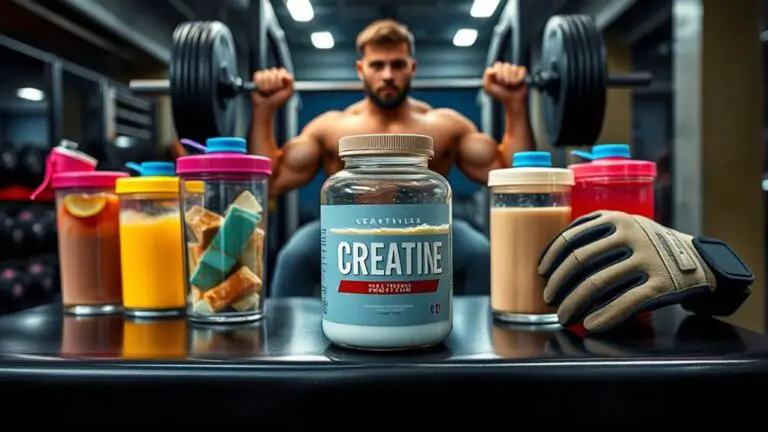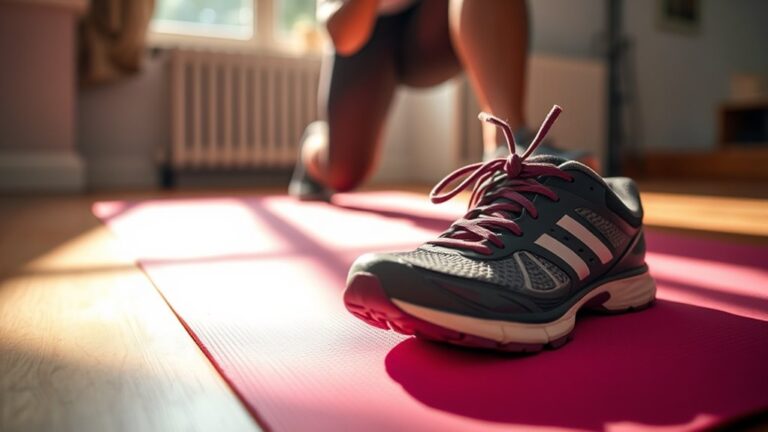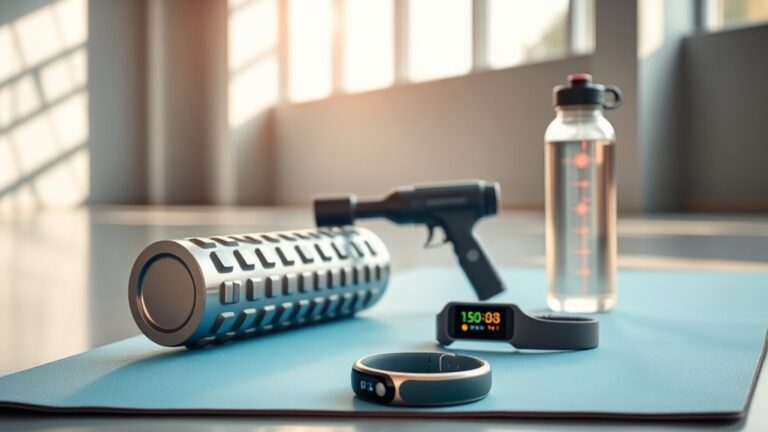How to Fix Tight Hamstrings for Better Gym Performance

To fix tight hamstrings and enhance your gym performance, focus on regular stretching and strengthening exercises. Incorporate dynamic stretches before workouts and static stretches afterward to improve flexibility. Use foam rolling to relieve muscle knots and perform exercises like hamstring curls and deadlifts for strength. Don’t forget proper warm-ups and cool downs to reduce injury risk. By embracing a consistent routine, you’ll release your potential and learn more effective strategies for ideal results.
Understanding the Anatomy of the Hamstrings
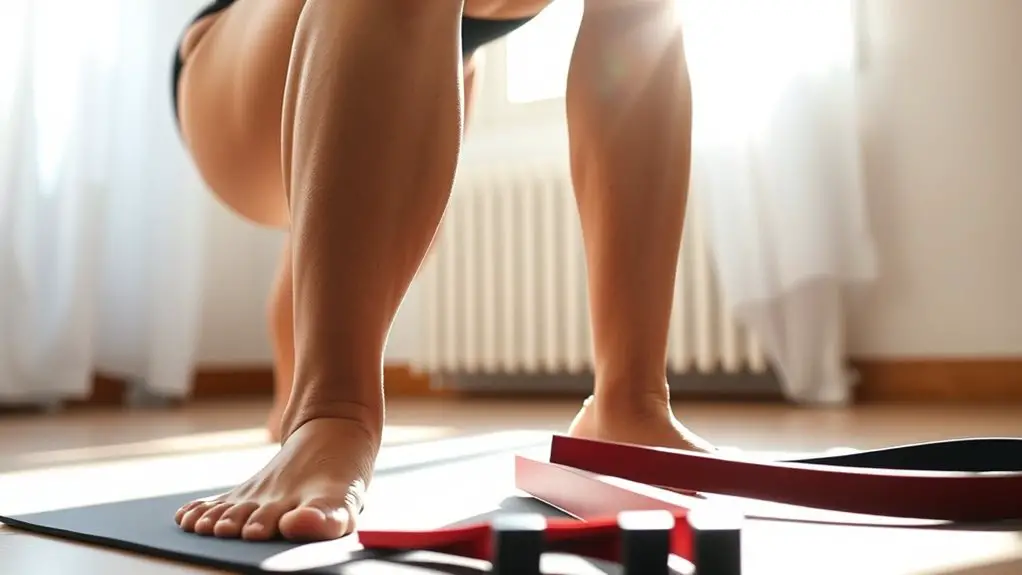
To truly understand how to fix tight hamstrings, you first need to grasp their anatomy. The hamstrings consist of three primary muscles: the biceps femoris, semitendinosus, and semimembranosus. These muscles run along the back of your thigh, connecting your pelvis to your lower leg. Each muscle is made up of muscle fibers that can vary in length and elasticity. When these fibers become tight or overworked, it can limit your mobility and performance.
Understanding hamstring anatomy helps you identify which areas may be contributing to your tightness. By knowing the specific functions of each muscle, you can target your stretching and strengthening exercises more effectively. This knowledge not only aids in alleviating tightness but also enhances your overall athletic performance. Remember, a well-informed approach will empower you to take control of your fitness journey and achieve your goals.
Common Causes of Tight Hamstrings
Tight hamstrings can often stem from a sedentary lifestyle, where limited movement leads to stiffness. Additionally, insufficient flexibility training and muscle imbalances can exacerbate the issue, making it essential to understand these factors. By recognizing these common causes, you can take proactive steps toward improving your hamstring health.
Sedentary Lifestyle Impact
When you lead a sedentary lifestyle, it’s easy to overlook the strain it places on your body, particularly your hamstrings. Sedentary habits, like sitting for long periods, contribute to muscle stiffness and can lead to tightness in your hamstrings. This tightness not only affects your flexibility but can also hinder your performance in the gym. It’s essential to recognize that extended inactivity can weaken these vital muscles, making them more susceptible to injury. By incorporating regular movement, stretching, and strengthening exercises into your routine, you can combat the negative effects of a sedentary lifestyle. Embrace the change, and remember that even small steps can make a significant difference in improving your hamstring health and overall performance.
Poor Flexibility Training
Many people don’t realize that poor flexibility training can greatly contribute to tight hamstrings. If you neglect to incorporate both dynamic stretches and static stretches into your workout routine, you might find your hamstrings becoming increasingly stiff. Dynamic stretches, performed before workouts, prepare your muscles for action, enhancing blood flow and flexibility. On the other hand, static stretches, which should be included post-exercise, help to lengthen and relax those muscles. Without a balanced approach to flexibility training, you risk not only tight hamstrings but also potential injuries. By committing to a consistent flexibility routine, you’ll improve your overall performance in the gym and enjoy greater mobility in your daily life. Don’t let tight hamstrings hold you back!
Muscle Imbalance Issues
Muscle imbalances can greatly contribute to tight hamstrings, often arising from overactive or dominant muscle groups that overshadow their weaker counterparts. For instance, if your quadriceps are excessively tight, they may inhibit proper muscle recruitment in your hamstrings, leading to discomfort and restrictions in movement. To address this, incorporate targeted flexibility training that focuses on both strengthening weaker muscles and stretching overactive ones. Engaging in exercises like hip flexor stretches and hamstring strengthening can help restore balance. Remember, it’s essential to listen to your body and adjust your routine accordingly. By addressing muscle imbalances and enhancing flexibility, you’ll not only relieve tightness but also improve your overall gym performance, allowing you to reach your fitness goals more effectively.
The Importance of Stretching
When it comes to improving tight hamstrings, regular stretching is essential for enhancing flexibility and preventing injury. You’ll find that incorporating specific stretching techniques into your routine can yield impressive results. Timing your stretches effectively can further maximize these benefits, setting you up for success in your flexibility journey.
Benefits of Regular Stretching
While you might not realize it, incorporating regular stretching into your routine can greatly enhance your overall well-being. Here are some key benefits you’ll experience:
- Injury prevention: Stretching helps maintain muscle elasticity, reducing the risk of injuries during workouts.
- Performance enhancement: Engaging in both dynamic stretches before activities and static stretches afterward can considerably improve your athletic performance.
- Muscle recovery: A proper flexibility routine aids in quicker muscle recovery, allowing you to get back to your training faster.
Stretching Techniques to Try
Incorporating effective stretching techniques into your routine not only enhances flexibility but also plays an essential role in maintaining overall muscle health. To improve your hamstring flexibility, try dynamic stretches before your workouts, like leg swings and walking lunges. These movements warm up your muscles and prepare them for activity. After your workout, focus on static stretches such as seated forward bends and standing hamstring stretches. These help lengthen the muscles and promote recovery. Remember, consistency is key; aim to incorporate both types of stretches regularly. By committing to these techniques, you’ll not only alleviate tightness but also boost your gym performance, making every workout more effective and enjoyable. Embrace the journey to stronger, more flexible hamstrings!
Timing Your Stretch Routine
Timing your stretch routine is essential for maximizing benefits and preventing injury. To effectively incorporate stretching into your workouts, consider these key points:
- Dynamic stretching is ideal before workouts, as it prepares your muscles and increases blood flow.
- Static stretching should follow your workout, helping to improve flexibility and aid recovery.
- Consistency is vital; make stretching a regular part of your routine to see lasting improvements.
Effective Stretching Techniques
Effective stretching techniques can greatly improve flexibility and alleviate the discomfort associated with tight hamstrings. Incorporating both dynamic stretches before your workout and static stretches afterward is essential for ideal results. Dynamic stretches enhance blood flow, preparing your muscles for activity, while static stretches help in lengthening muscles post-exercise.
Here’s a quick comparison of both techniques:
| Type of Stretch | Purpose |
|---|---|
| Dynamic Stretches | Increase blood flow & mobility |
| Static Stretches | Improve flexibility & recovery |
Start with dynamic movements like leg swings or walking lunges to warm up. After your workout, engage in static stretches such as the seated hamstring stretch or standing toe touch to promote flexibility. Remember, consistency is key! By integrating these techniques into your routine, you’ll not only relieve tightness but also enhance your overall gym performance.
Incorporating Foam Rolling

Foam rolling is a powerful addition to your routine, complementing the benefits of stretching by targeting muscle knots and tightness directly. Incorporating foam roller techniques into your regimen can greatly enhance your hamstring flexibility and overall performance. By practicing self myofascial release, you can alleviate tension and improve blood flow to the muscles.
- Use the foam roller before and after workouts to maximize benefits.
- Focus on slow, controlled movements to effectively release tightness.
- Target specific areas like the hamstrings, quadriceps, and glutes for thorough relief.
Strengthening Exercises for Hamstrings
While stretching is essential for flexibility, strengthening your hamstrings is equally important for overall muscle balance and injury prevention. Strong hamstrings support your knees and improve your performance in various exercises. One effective way to target these muscles is through hamstring curls. You can perform them using a machine, resistance bands, or even at home with a stability ball.
Incorporating deadlift variations, like conventional or Romanian deadlifts, is another excellent method to strengthen your hamstrings. These compound movements engage multiple muscle groups, increasing overall strength and stability. Aim for two to three sets of 8-12 repetitions for each exercise, adjusting the weight according to your capability.
Consistency is key, so integrate these exercises into your routine to see improvement. By focusing on strengthening your hamstrings, you’ll enhance your gym performance and reduce the risk of injury, helping you achieve your fitness goals more effectively.
The Role of Warm-Up and Cool Down
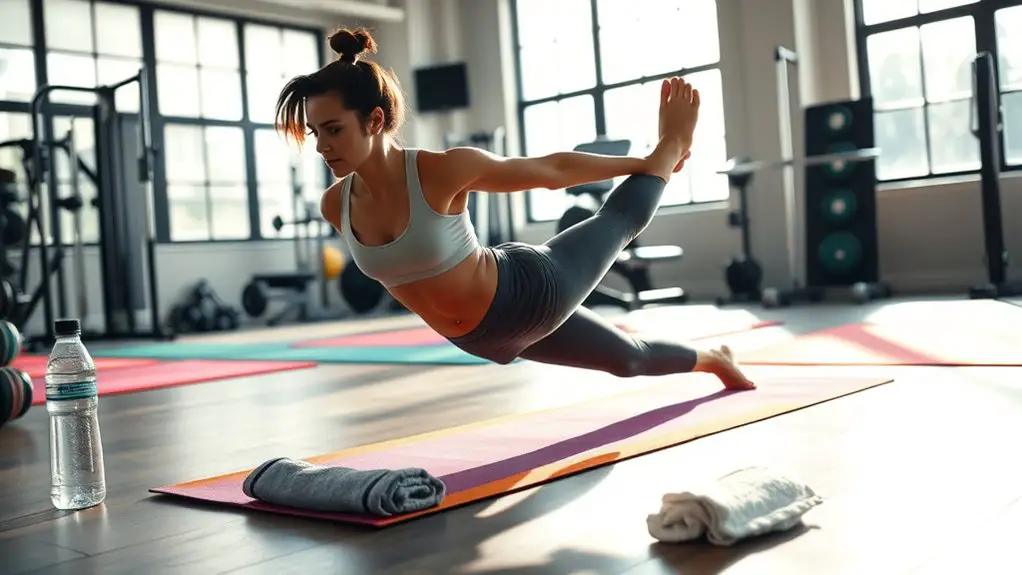
Incorporating a proper warm-up and cool down into your routine can greatly enhance your hamstring strength and flexibility. These essential components prepare your muscles for action and help them recover afterward.
Incorporating warm-ups and cool downs boosts hamstring strength and flexibility, preparing muscles for action and aiding recovery.
- Dynamic stretching activates your muscles and increases blood flow, making your hamstrings more pliable for intense workouts.
- A proper cool down with static stretching helps maintain flexibility and reduces muscle tightness post-exercise.
- Consistent warm-ups and cool downs can prevent injuries, allowing you to train consistently and effectively.
When to Seek Professional Help
When should you consider seeking professional help for tight hamstrings? If you’re experiencing persistent discomfort or pain despite regular stretching and foam rolling, it’s time to consult a healthcare professional. Signs of tightness can include stiffness during movement, decreased range of motion, or pain that radiates into your lower back or knees. These symptoms might indicate an underlying issue that needs addressing.
If you notice that your tight hamstrings are affecting your gym performance or daily activities, don’t hesitate to reach out for guidance. A physical therapist or sports chiropractor can provide tailored strategies to alleviate your discomfort and improve flexibility. Remember, addressing tightness early can prevent more severe injuries down the line. You’re investing in your health and fitness journey, so take that next step to guarantee your body is functioning at its best!
Maintaining Long-Term Flexibility
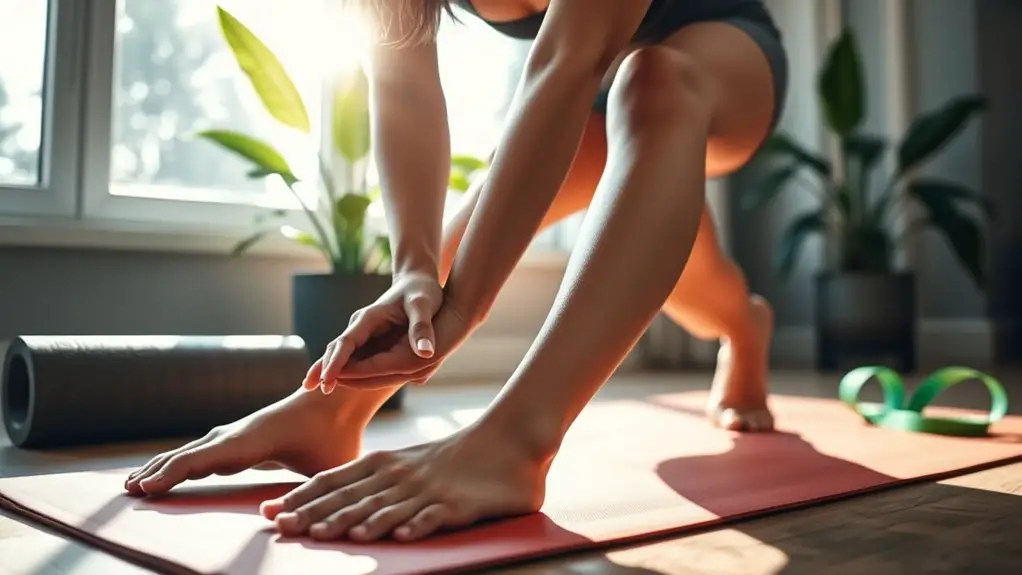
To maintain long-term flexibility in your hamstrings, it’s essential to adopt a consistent routine that includes stretching, strengthening, and mindful movement practices. By focusing on these elements, you can cultivate dynamic flexibility, which greatly contributes to your overall performance in the gym. Remember, flexibility isn’t just about range of motion; it’s about enhancing your strength and stability too.
Maintaining hamstring flexibility requires a consistent blend of stretching, strength training, and mindful movement practices for optimal performance.
Consider incorporating the following into your routine:
- Dynamic Warm-Ups: Engage in mobility exercises that prepare your muscles for activity.
- Regular Stretching: Incorporate both static and dynamic stretches to guarantee balanced flexibility.
- Strength Training: Focus on exercises that target the hamstrings while promoting overall leg strength.
Frequently Asked Questions
Can Tight Hamstrings Affect My Posture?
They say, “You can’t stand tall if you don’t stretch.” Tight hamstrings can indeed affect your posture, pulling your pelvis down and causing misalignment in your spine. This tension can lead to discomfort and even pain over time. To combat this, focus on posture correction through regular flexibility training. By incorporating stretches and mobility exercises, you’ll not only improve your posture but also enhance overall body function and well-being.
How Often Should I Stretch My Hamstrings?
You should aim for daily stretching of your hamstrings to improve flexibility and reduce tightness. Incorporating stretching routines into your daily regimen can greatly enhance your overall mobility and performance. Even just 10-15 minutes a day can make a difference. Remember to listen to your body and adjust the intensity as needed. Consistency is key, so find a time that works for you and stick to it for the best results.
Are There Specific Sports That Worsen Tight Hamstrings?
Did you know that around 60% of soccer players experience hamstring injuries? Sports like soccer and running can worsen tight hamstrings due to their intense demands on running mechanics. The explosive movements and repetitive strain can lead to tightness if you don’t prioritize flexibility. To improve your performance, make sure you incorporate regular stretching and strengthening exercises in your routine. It’ll pay off in preventing injuries and enhancing your overall athletic ability.
What Are the Signs of a Hamstring Strain?
When it comes to hamstring strain symptoms, you might notice sharp pain at the back of your thigh, swelling, or bruising. You could also experience stiffness or a limited range of motion. If you think you’ve strained your hamstring, it’s essential to implement recovery strategies like resting, icing, and gentle stretching. Staying proactive in your recovery can help you bounce back stronger and prevent future injuries. Remember, listening to your body is key!
Can Tight Hamstrings Lead to Lower Back Pain?
Yes, tight hamstrings can definitely lead to lower back discomfort. When your hamstrings lack flexibility, they can create tension in your pelvis and spine, resulting in improper alignment and strain on your lower back. To prevent this, focusing on hamstring flexibility is essential. Incorporating regular stretching and mobility exercises can help alleviate tension, ultimately improving your overall posture and comfort. Remember, investing time in flexibility pays off in your physical well-being and performance.
